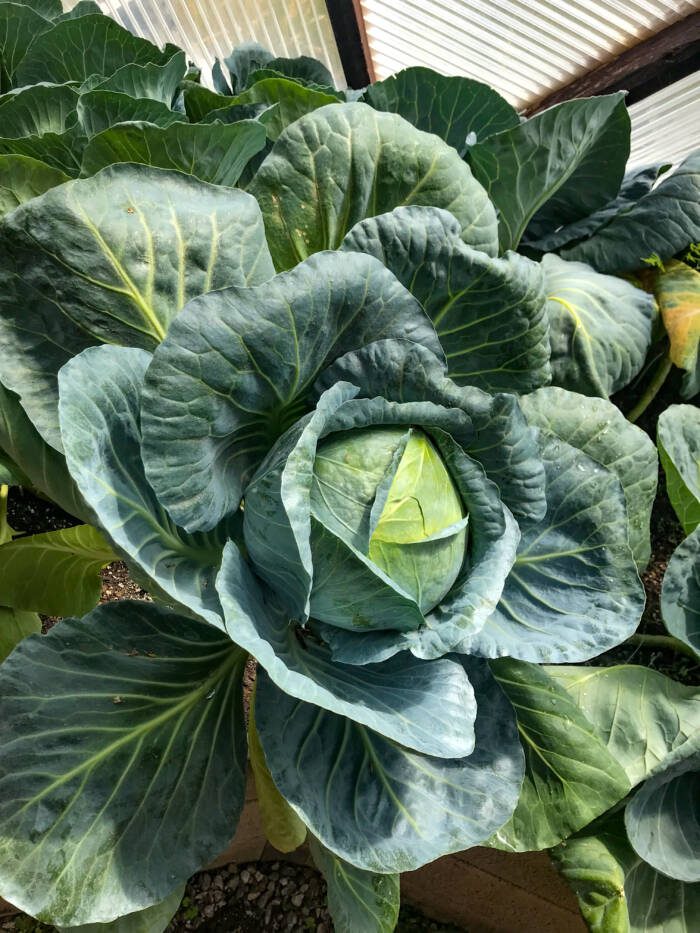
Featured Plant of the Month: Cabbage!

Cabbage or Brassica oleracea is from the Brassicaceae family and is native to Europe. Cabbage was domesticated prior to 1000 BC and was a table luxury in the Roman Empire. In the Old Country of Ireland cabbage became important due to food insecurity, that’s right, even back in the 1700s some struggled to put food on the table. In the 1600s the English crown forced land laws upon the Irish and Irish farmers became tenant farmers. With the high rent charged by British landlords, farmers barely had enough food to feed their families, but potatoes grew a high yield, and cabbage grew well in Irish soil so this is what they lived on.
Some lucky farmers also raised pigs that provided protein for their families, but most livestock was also used for rent. This is one of the reasons for the traditional potato and cabbage (or kale) dish, Colcannon. The potato blight of 1845 destroyed potato crops and as this was the staple in their diet, over one million people died in Ireland in less than five years. As the famine raged on, many Irish immigrated to America. Although they brought many traditions with them, beef and cabbage were cheaper at that time than pork and potatoes and this is how the tradition of corned beef and cabbage actually came about in America.
Growing Cabbage
Growing cabbage from seed is easy. Plant seeds ¼” deep where they can get sun, but they also need shade to keep them cool in the summer sun, even in your dome! Too much sun can also cause cabbage to taste bitter. When the seedlings reach 5” thin them out so they have enough room to grow. It’s good to give them about 20-24” per plant. Cabbage is a heavy feeder that does best watered well (about an inch per week) and the soil should be slightly moist, but not soggy. It prefers loamy soil with lots of compost mixed in and it’s helpful to plant companion plants that will add to the soil rather than compete for nutrients.

Cabbage Fun Facts
- Traditionally farmers plant cabbage seeds on St. Patrick’s Day, but old-time farmers wore their nightclothes when they planted seeds so the plants would grow better. Of course, that was before the invention of cell phones, so maybe don’t try that when planting your seeds!
- Bonnie Plants has a Cabbage growing program for students: dig into it here!
- Scott Robb of Palmer, Alaska, is the world record title holder of the largest cabbage. He won that title in 2012, with a cabbage weighing in at 138.25 pounds.
- Did you know that Babe Ruth used to wear a cabbage leaf under his baseball cap during games? Maybe it’s because Chinese scrolls from 1000 BC claimed cabbage helped cure baldness.
Cabbage Companion Plants
Companion plants are like bringing friends together for a garden party, cabbage will flourish when planted with friends. Since other brassicas need the same nutrients as cabbage, they can be planted near your cabbage; it’s like a family reunion! Broccoli, Brussels sprouts, cauliflower, kale, and swiss chard are wonderful companion plants and like the same conditions and climate. Don’t go too crazy planting all of them as they can out-compete each other. See, just like a family reunion where everyone is over-talking and sharing stories!
Your cabbage also needs shade from the afternoon sun, enter friendly peas, and bush beans. Not only will they provide shade, but they will provide nitrogen to the soil. All members of the cabbage family need a lot of nitrogen to grow those gorgeous leafy greens. Root vegetables such as carrots, onions, and parsnips are also great friends to cabbage because as they grow they bring nutrients up to the top of the soil where the shallower cabbage roots can benefit. Rosemary and sage act as a repellent to cabbage moths and rosemary will also improve the flavor of your cabbage since it provides calcium, potassium, and sulfur to your soil. And marigolds, the Miss Congeniality of the companion planting world, are perfect to plant. To learn more about the benefits of companion planting click this link: https://www.almanac.com/content/companion-planting-herbs
How to Harvest Cabbage
Cabbage matures around 70 days when the head is firm and they are the size you want. To harvest cabbage cut the stem at the base, remove any yellow leaves, and bring it inside. You can also get a second, smaller harvest if you cut the stem (as long as the stem does not split), but leave the outer leaves intact and leave the roots in the planter bed. Another option is to harvest your cabbage, roots, and all, and hang it in a root cellar for up to three months provided the temperature is between freezing and 45 degrees. Cabbage is an excellent plant for your Dome because it is packed full of vitamins and minerals, especially Vitamin K, Vitamin C, and folate. The purple varieties also have anthocyanins which have been proven to possess cancer-fighting properties so cabbage is a superhero!


Cabbage is well worth growing in your Dome and we wish you as much luck as the Irish in growing it! 🍀 We hope you will share your recipes with us, too. I’m looking forward to trying the traditional Irish Colcannon. And here’s an Irish blessing to share with you: Happiness being a dessert so sweet, May life give you more than you can ever eat. May you have Suaimhneas (sue-uv-ness) or peace in your beautiful Dome!
